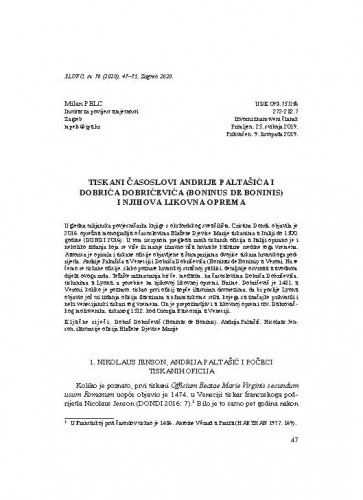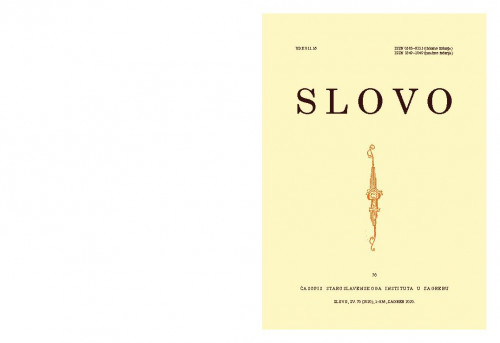Ugledna talijanska povjesničarka knjige s oksfordskog sveučilišta, Cristina Dondi, objavila je 2016. opsežnu monografiju o časoslovima Blažene Djevice Marije tiskanima u Italiji do 1500. godine (DONDI 2016). U tom iscrpnom pregledu ranih tiskanih oficija u Italiji opisano je i nekoliko izdanja koja se više ili manje izravno tiču hrvatske kulturne sredine toga vremena. Autorica je opisala i tiskane oficije objavljene u štamparijama dvojice tiskara hrvatskoga podrijetla: Andrije Paltašića u Veneciji i Dobrića Dobrićevića (Boninus de Boninis) u Veroni. Na te ćemo se tiskane oficije, slabo poznate hrvatskoj stručnoj publici, detaljnije osvrnuti u uvodnom dijelu ovoga rada. Težište razmatranja bit će, međutim, na časoslovima Dobrića Dobrićevića, tiskanima u Lyonu, a posebice na njihovoj likovnoj opremi. Naime, Dobrićević je 1481. u Veroni, koliko je poznato, tiskao prvi oficij uopće ilustriran drvorezima, da bi poslije Lyonu objavio još tri izdanja oficija ilustrirana u »francuskom« stilu, kojega su značajke prihvatili i neki venecijanski tiskari tog vremena. On je prepoznatljiv i u likovnoj opremi tzv. Dubrovačkog molitvenika, tiskanog 1512. kod Giorgia Rusconija u Veneciji.; Two printers of Croatian origin, Andrija Paltašić in Venice and Dobrić Dobrićević (Boninus de Boninis) in Verona, were among the first to publish printed editions of the Office of the Blessed Virgin Mary: Paltašić 1478, Dobrićević 1481. Dobrićević’s edition is the first known woodcut-illustrated edition of the office. Later on, he published three more illustrated editions of Virgin Mary's Office in Lyon. This makes his contributions to the history of breviary printing more significant than those by Paltašić. Dobričević's four office editions (1481, two in 1499, and one in 1501) consistently reflect the Italian and French traditions in terms of their content, iconography and visual art. The Verona edition is in complete correspondence with the Italian tradition, while the French tradition is reflected in his Lyon editions. The breviaries modelled on the French tradition are more extensive in their content compared to the Italian ones. They contain a larger number of New Testament texts and accompanying illustrations from the lives of Jesus and Mary. This makes the artistic, iconographic and decorative value of the French editions much more significant than that of the Italian editions. In this paper special attention is given to a copy of Dobričević’s Office from 20 March 1499, printed on parchment, which originates from Emmanuele Cicogna’s collection and is currently kept in the Museo Correr Library in Venice. Seeing as the copy had been damaged, Cicogna (according to his own handwritten notes on the inside cover) added pages and images from another copy of the same edition printed on paper, which is currently kept in fragments in the National Library of St Mark's in Venice. The parchment copy from Cicogna’s collection provides a unique testimony of the interactive relationship between office users and its illustrations.
Sažetak

 Slovo : časopis Staroslavenskoga instituta u Zagrebu : 70(2020) / glavna i odgovorna urednica Vida Vukoja.
Slovo : časopis Staroslavenskoga instituta u Zagrebu : 70(2020) / glavna i odgovorna urednica Vida Vukoja.